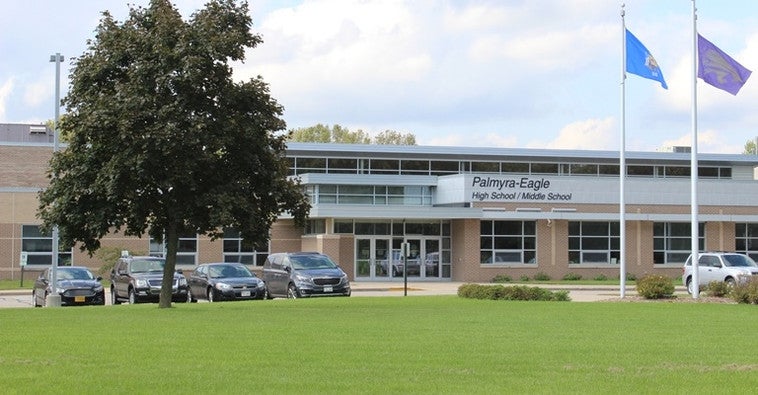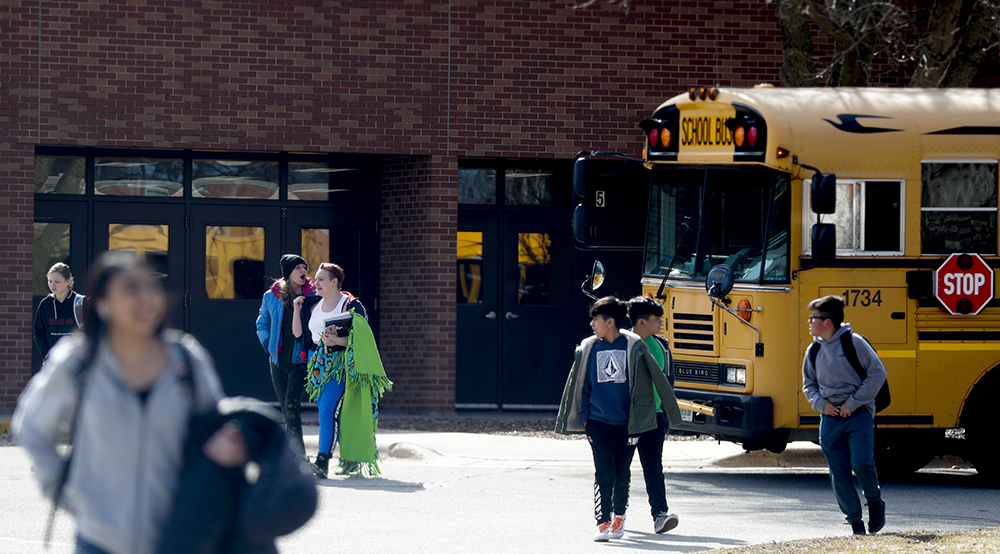A rural southeastern Wisconsin school district won’t dissolve after a state board denied its petition Thursday.
Now district leaders face new decisions about how to maintain the financially strapped district and keep it going forward.
News with a little more humanity
WPR’s “Wisconsin Today” newsletter keeps you connected to the state you love without feeling overwhelmed. No paywall. No agenda. No corporate filter.
The school board in the Palmyra-Eagle Area School District in July voted to dissolve the district, a move that would have required the state to assign students to neighboring districts. But it would also have required the state to assign the district’s reported $12.8 million in debt to its neighbors. Among other factors, that was one reason the state’s School District Boundary Appeals Board voted 6-1 against dissolution. The vote followed a series of emotional public hearings in the district during the last month at which residents pleaded with the board to keep the district intact.
Tara LeRoy of Palmyra has two kids in the district. She’s led efforts to keep the district from dissolving. She said the late-afternoon meeting in the school gym in Palmyra was packed with students, parents and community members.
“Everyone was decked out in their Panther gear,” LeRoy said, referring to the high school’s mascot. “Everyone was holding hands.”
When the board’s vote was tallied and dissolution was denied, she said, the room erupted in cheers.
“There is no feeling like making hundreds of kids clap and cheer, and knowing that they get to keep their school,” LeRoy said.
Members of the Boundary Appeals Board were critical of the process.
One of them told the Milwaukee Journal Sentinel that the district’s dissolution process was “rushed” and didn’t give the district enough time to explore all of its options. And neighboring districts were nervous about the impact of absorbing Palmyra-Eagle students and finances as well. For example, officials in the Whitewater Unified School District told the Janesville Gazette they had concerns about how Palmyra’s dissolution would affect their own class sizes and school district finances.
The sole vote in favor of dissolution came from the board’s representative of the state Department of Public Instruction. In a statement, state Superintendent Carolyn Stanford Taylor affirmed her support for dissolution but said the board was “faced with a question that had no perfect answer.”
The school board vote to dissolve followed the defeat of an $11.5 million school funding referendum in April. That referendum would have funded district operations, and when it failed, district leaders felt they had no choice but to dissolve.
“We understand there’s no good emotional reason to close this school district,” said Palmyra-Eagle School Board President Scott Hoff. “I’ve got four kids in the district myself. This absolutely is awful. But when you look at the finances … you can’t get there from here.”
Hoff said the school board will begin a budget process next week that seeks to make $2 million in cuts from the district’s $14 million budget.
LeRoy, who is running for school board in the spring election, said the district will face difficult choices about how to continue, including the potential closure of an elementary school. She said one proposal would involve the closure of the Palmyra Elementary School and its consolidation with Eagle Elementary School.
One of the problems the district has faced is a stark divide in public opinion between its two main municipalities, Palmyra and Eagle. A majority of voters in Eagle, a Waukesha County village on the east side of the district, voted against the April referendum and favored dissolution in a November advisory referendum vote. Majorities of voters in Palmyra, a Jefferson County village on the west of the district, voted in favor of the referendum and against dissolution.
It’s as if the two communities “got married over money 50 years ago, but they’ve always slept in separate bedrooms,” Hoff said. “The schools are the only tie between the two communities.
As the process played out, the potential dissolution of the district was seen as a cautionary tale for rural school districts across the state, which increasingly have turned to referendums to fund operations or stave off drastic cuts.
Hoff said the state’s move could lead to unintended consequences. The decision, he said, could make it more difficult for districts elsewhere in the state to pass an operational referendum, because in essence the state’s message to voters in the Palmyra-Eagle district was that even voting down the operational referendum didn’t, in the end, lead to dissolution.
LeRoy, who says she believes the district will need to make painful cuts, said part of the blame for Palmyra-Eagle’s predicament falls on the writers of the state budget.
“It should never have come to this,” LeRoy said. “Shame on legislators and policymakers who are not adequately funding our public education system in Wisconsin.”
Wisconsin Public Radio, © Copyright 2025, Board of Regents of the University of Wisconsin System and Wisconsin Educational Communications Board.







